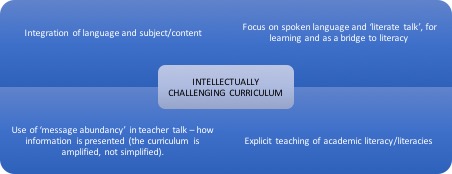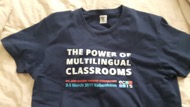Graham Smith is the managing director of The EAL Academy, one of the EAL Journal’s sponsors. In this post he reports on a recent International Schools conference that had much to contribute to the debate at home.

Every three years ECIS (Educational Collaborative for International Schools) and ESLMT (English as a Second Language and Mother Tongue) organise a very big conference, generally in major European city. It is, it has to be said, not a cheap conference, especially when it is in an expensive city like Copenhagen, this year’s venue. However, you do get a lot for your money, not least the joy of Jim Cummins, Pauline Gibbons and Steven Krashen all under one roof and performing at least three times over the course of two and a half days.
The majority of delegates were from international schools, but I also saw colleagues from Enfield and Durham LAs and Copenhagen City Council. And there was also Nicola Claire, the woman behind the learn in your first language free school proposal for Peterborough. In addition, it was good to run into Brian Dare, whom may readers will know from LiLAC and How Language Works tutor training.
Pauline Gibbons was, as always, wonderful. In her workshop on Classroom Talk as a
Bridge to Literacy she managed in a round an hour to get participants – by reflecting, talking informally and pairs and groups to check understanding and then giving formal, oral instructions – to make such good sense of a text in Zulu that all we needed was another ten minutes for the formal writing. The outline of Gibbons’ keynote (see diagram) describes very simply what our advanced EAL learners need. She explained the concept of ‘message abundancy’ through her own reliance on Sat Nav. It tells you what you need to know in written and spoken words and in visuals. It give you information when you need it and it keeps telling in different ways until you get it.

Stephen Krashen remains a key figure in our understanding of the language acquisition process and is a brilliant stand-up comedian with a distinct gift for polemic.
Jim Cummins has consistently been one of the most open-minded thinkers in our field over the last 40 years and talked engagingly about the shift from ESL and Mother Tongue to developing a multilingual pedagogy and the importance of the debate translanguaging that featured in a number of conference workshops and presentations. In the closing conference panel he was also clearly the speaker with the widest knowledge of current research. Just in case you didn’t follow through the multiple language of instruction free school link earlier, he also offered his backing to that project.
The conference presentations are easily accessed, but I would just like to highlight three that I found useful and sometimes amazing.
Joris Van den Bosch’s fascinating blog on the innovative use of home languages featured in a previous issue of the EAL Journal. His conference presentation was a series of strategies for making linguistic diversity an aid to effective learning. Once you’ve heard them, they become so obvious that you wonder why you didn’t think of them yourself. The multilingual story of events and reverse translation will work really well in UK classrooms.
Marco Tamburelli’s research on attitudes to language suggested that the rise of Welsh as a language of power has resulted in male, native Welsh speakers aged 16-19 starting to regard Welsh as distinctly uncool.
The International School of Prague has been training its students to be linguists using language corpora. Its Applied Linguistics Project equips its students to write formal academic papers in English addressing the issues that they have as EAL learners. Scroll down to the video of students presenting their research at Charles University in Prague. Lots of us talk about the importance of giving students a language for talking about language. In Prague they have gone much further than that.

So I now have the t-shirt. Though age leaves me a little unwilling to model the t-shirt, the conclusion of the conference resolved a long argument among teachers in international schools but posed a challenge for those of us who work in UK state schools about labelling what we do as EAL. The ESLMT Committee has long debated whether it has the right name. The conference closed with the announcement of a new name: the Multilingual Learning in Education Committee.
EAL practice in the UK is well regarded across the world, so well regarded that The EAL Academy now spends much of its time in Europe exporting that practice to schools and local authorities with multilingual populations and high numbers of newly arrived refugees. English as additional language describes what do we much better than English as a second language ever did, but does the label hinder us if we want to do the exciting things that Joris van den Bosch and others do in their multilingual classrooms?

The EAL Journal is published termly by NALDIC, the subject association for EAL. Visit www.naldic.org.uk to become a member.


